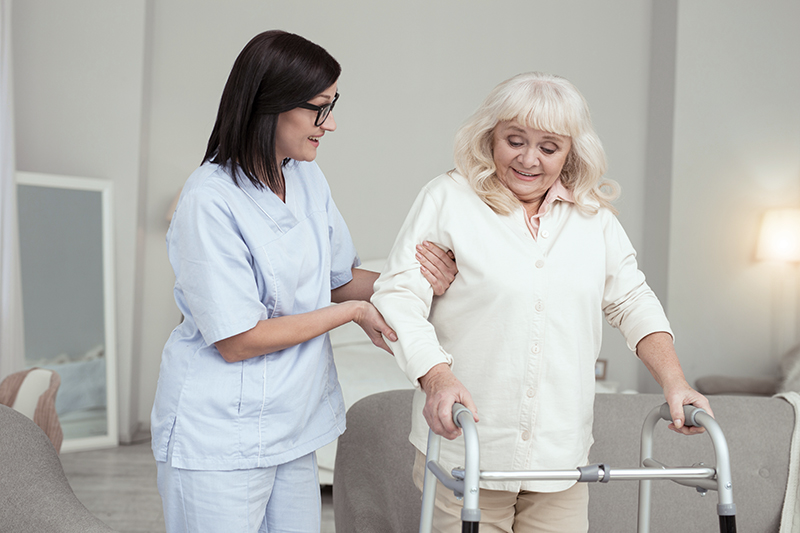Recovery after surgery. Regaining mobility and improving quality of life
3 minute(s) read

Share
Mobility problems in the elderly largely interrupt daily life and activities. Loss of mobility has profound social, psychological and physical consequences which impair quality of life. Post-operative rehabilitation plays a vital role to enhance mobility and improve quality of life, particularly in patients with injuries and elderly patients who had bone diseases and underwent orthopedic surgeries such as spine, arm and leg, shoulder, knee, hip, ankle and foot.
Objectives of rehabilitation in patients with orthopedic surgery
The ultimate goals of rehabilitation care after orthopedic surgery include:
- Reduce pain with satisfied outcomes among individuals.
- Enhance bone fusion as much as possible.
- Preserve and maintain implant function as well as prolong its life span.
- Prevent other related complications such as implant wear, loosening, or dislocation and infections.
- Re-establish joint motion and muscle strength around the joint.
Recovery program after surgery
After receiving surgical treatments for orthopedic diseases, an immediate post-operative rehabilitation program should be applied as soon as possible in order to promptly restore the functions of affected muscles and ligaments. More importantly, rehabilitation care essentially requires coordinated attempts from a large team, including medical professionals specialized in post-operative rehabilitation, patients, family and friends. To provide comprehensive rehabilitation program, post-operative rehabilitation involves multidisciplinary approach which is consisted of orthopedic surgeons, rehabilitation doctors, geriatric doctors, physiotherapists, rehabilitation nurses and mental health professionals as well as physical and recreational therapists.
Immediate rehabilitation is a key to facilitate a quick recovery. Comprehensive post-operative rehabilitation program is individually designed to promote healing, reduce pain and swelling, restore joint mobility as well as enhance flexibility and strength. Supported by rehabilitation equipment and proper exercise with optimal duration, patients can quickly return to normal life and activities. In addition, recovery program varies among individuals, depending on age, type of surgery, affected area, underlying diseases and personal health conditions.
Movement rehabilitation after surgery
Rehabilitation of movement is extremely important, especially walking ability to enhance patient’s mobility and independence. Home settings and environmental modifications are crucial in order to support patient’s movement and activities of daily living. Before returning home, walking program for individual patients has been created by a multidisciplinary team which is well equipped with advanced technology and rehabilitation instruments. Walking significantly helps to restore joint mobility as well as enhance muscle strength. In addition, self-independence could be regained when patients are able to ambulate by themselves.
The recommendations of putting weight on the affected leg (s) e.g. broken leg or after knee implant must be strictly followed. The recommendations are made based primarily on the location of affected areas, type of fractures and surgery. Patients might be instructed to entirely avoid putting weight on the affected leg or partly put some weight on the injured leg. The entire weight might be allowed to be put on the affected leg in some cases. Besides walking, other programs e.g. balance and coordination, fall prevention and using walking aids must be applied collectively.
The primary goal of post-operative rehabilitation is to improve patients’ level of functioning so that they can become as independent as possible. Learning skills include walking on the flat surface, stair climbing, showering and bathing. Additionally, emotional support and mental practice combined with psychological counseling can significantly improve rehabilitation outcomes. Well-trained and highly experienced caregivers contribute a major impact to the patients by encouraging patient’s mobility while ensuring minimized chances of developing further complications.
At Chiva Transitional Care Hospital, we are committed to deliver comprehensive rehabilitation care with multidisciplinary team supported with advanced technology in order to accomplish the best possible treatment results. To provide holistic rehabilitation programs, our multidisciplinary team is consisted of rehabilitation doctors, geriatric doctors, physiotherapists, rehabilitation nurses and mental health professionals as well as physical and recreational therapists. With our intensive rehabilitation programs, recreation activities and home-like environment, we have aimed to holistically improve patient’s quality of life while ensuring certain degree of independence before returning home to their family.
For more information, please contact
Share
